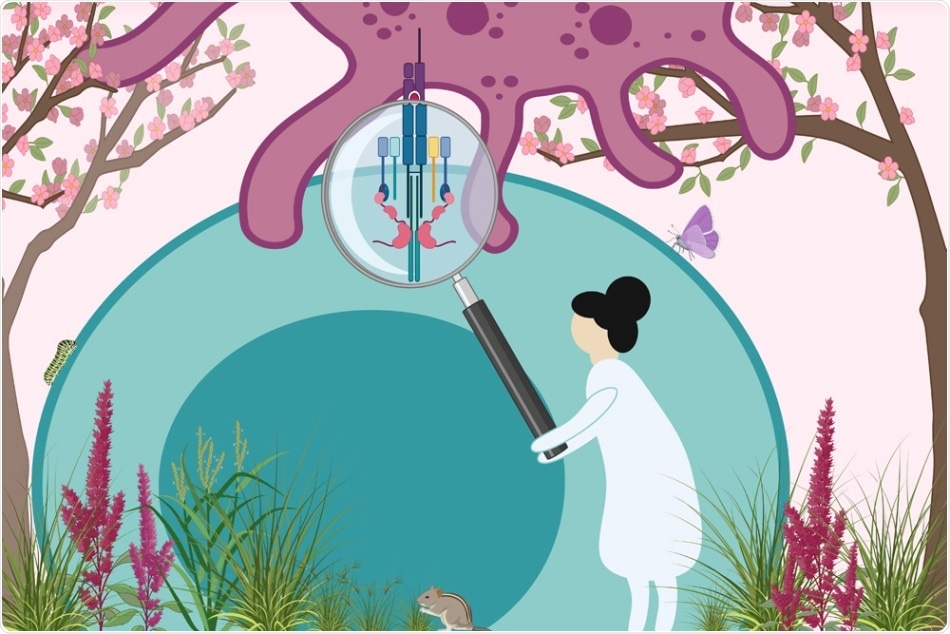Within the immune system, the T lymphocytes operate to kill cancer cells or infected cells. But to do this, they have to find the threat first: molecules recognized as foreign—the supposed antigens—adhere to the T-cell receptor on the surface of T cells.

T lymphocytes use the T-cell receptor (under the magnifying glass) to identify cells that are infected with viruses and bacteria or tumor cells. Researchers from Freiburg have discovered how the receptor activates the T cells to destroy infected and tumor cells. “This immune response protects us and allows us to live in harmony with nature,” says Susana Minguet of her illustration. Image Credit: Susana Minguet.
Now, research teams, headed by Dr Susana Minguet and Professor Dr Wolfgang Schamel from signaling research Clusters of Excellence BIOSS and CIBSS (Centre for Integrative Biological Signalling Studies) at the University of Freiburg, have successfully demonstrated how T cells are activated by this identification mechanism to change to the attack mode.
The researchers explained a previously unknown domain of the T-cell receptor and showed that this supposed RK motif enhances immune treatments against cancer in pre-clinical studies. The study has been published in the Nature Immunology journal.
The T-cell receptor is a minuscule machine composed of several individual proteins. When the T-cell receptor detects a tumor or an infected cell in the body, a kinase specific to a so-called lymphocyte adheres to the T-cell receptor at the newly detected RK motif. Such a binding turns on the T-cell receptor and stimulates the T cell to turn into a killer cell and thus remove the threat.
Referring to this latest finding, Drs Minguet and Schamels stated, “We were astounded that this RK motive has never been described before. Immunologists have been studying the T-cell receptor for more than 30 years now.”
These discoveries help researchers to close the gap between the activation of the immune response and the perception of a threat at the molecular level, providing a better understanding of a crucial operating principle of the immune system.
T cells fulfill various functions
Cytotoxic T cells are supposed killer cells specifically responsible for damaging the body’s own cells when they present a danger to it. This is because these cells have been infected by viruses or bacteria, or because they have converted into cancer cells. Moreover, the T cells identify antigens only on cells and subsequently discharge harmful substances to kill these target cells.
In immunotherapy used for curing cancer, physicians attempt to reinforce this potential of the immune system. CAR T-cell therapy is already being used effectively to treat patients at the Medical Center in the University of Freiburg. This therapy employs artificial receptors that are produced in the laboratory on patient-derived T cells to destroy particularly the cancer cells of the very same patient.
In research performed at the Center for Chronic Immunodeficiency and in association with Professor Dr Robert Zeiser from the University Medical Center and also a member of CIBSS, the scientists showed in preclinical studies that CAR T cells including the RK motif kill more numbers of cancer cells when compared to T cells that lack this motif.
The researchers used a combination of immunology, biochemistry, and synthetic biology to discover the RK motif. They showed that the RK motif is generally concealed to inhibit un-desired T cell activation and it is detected only after it adheres to the antigen; this may explain why it was not detected until now.
This special combination of disciplines is the result of the integrative method used at the Cluster of Excellence CIBSS. The biochemical studies provide an in-depth insight into the molecular signals, while their medical application and immunological understanding explain their role in the body.
This discovery allows us to control T cells more precisely. And now we can do this very specifically, because this is the only cell type to use this novel activation mechanism. In the future, this may not only help in the treatment of cancer but possibly also improve therapies for autoimmune diseases or even immunodeficiencies.”
Dr Susana Minguet, Faculty of Biology/Cluster of Excellence CIBSS, University of Freiburg
Source:
Journal reference:
Hartl, F. A., et al. (2020) Noncanonical binding of Lck to CD3ε promotes TCR signaling and CAR function. Nature Immunology. doi.org/10.1038/s41590-020-0732-3.